An Assessment Method for the Impact of Electric Vehicle Participation in V2G on the Voltage Quality of the Distribution Network
Abstract
:1. Introduction
2. V2G Model Based on EV Driving Characteristics
2.1. Electric Vehicle Charge-Discharge Model
2.1.1. Vehicle Arrival and Departure Times
2.1.2. Daily Mileage
2.1.3. The State of Charge before the Vehicle Participates in V2G
2.1.4. Charge and Discharge Time
2.1.5. Feature Parameters and Classification Criteria
- (1)
- When Estart > E1, the EV can immediately participate in the V2G scheduling when it drives into the destination;
- (2)
- When Estart ≥ E1 and Eend ≥ E1, the remaining power when the electric vehicle leaves can meet the owner’s subsequent car requirements;
- (3)
- If the electric vehicle participates in the V2G scheduling, calculate Δts and Δtp. If Δts ≤ Δtp, then the electric car is able to end charging and discharging during parking;
- (4)
- Compare the compensated electricity price with the charging price, if the pd > pc, then the owner is more willing to participate in the discharge. Referring to China’s time-sharing electricity price, the highest pc takes 0.9947 yuan/(kW·h).
- (1)
- Simulated driving state: First, the arrival and departure time of the electric vehicle, the driving distance of the single day, the SOC before participating in the V2G, the charging and discharging time, and the charging price and compensation price expected by the user are extracted, and the remaining battery power when the electric vehicle is driven in, the time required for charging and discharging, and the docking time are calculated;
- (2)
- Whether to participate in V2G: Based on the number of features of vehicle charge and discharge behavior, random sampling is used to determine whether electric vehicles participate in V2G;
- (3)
- Calculation of V2G load: In the case of electric vehicle participation in charge and discharge scheduling, the V2G time and load of the vehicle are calculated; in the case that the electric vehicle does not participate in the charge and discharge scheduling, only the charging time and load of the EV are calculated;
- (4)
- Judge the total number of participating vehicles and go back to step 1 to cycle until the last electric vehicle is judged.
3. EV Participates in the Power System Voltage Quality Assessment Method of Charge and Discharge
3.1. Latin Hypercube Sampling
3.1.1. Sampling
3.1.2. Arrangement
- (1)
- Initialize the permutation matrix LKN, each row of which contains an arbitrary permutation of l, 2, 3, ⋯, N;
- (2)
- Assuming that the correlation coefficient matrix of each row of LKN is ρL, then ρL is positively fixed and is a symmetric matrix, which is decomposed into a non-singular solid trigonometric matrix D using the Cholesky decomposition method:
3.2. Comprehensive Evaluation Index of Voltage Quality
4. Study Analysis
4.1. Example Description
4.2. Simulation Result Analysis
5. Conclusions
Author Contributions
Funding
Institutional Review Board Statement
Informed Consent Statement
Acknowledgments
Conflicts of Interest
References
- Lyu, L.; Yang, X.; Xiang, Y.; Liu, J.; Jawad, S.; Deng, R. Exploring high-penetration electric vehicles impact on urban power grid based on voltage stability analysis. Energy 2020, 198, 117301. [Google Scholar] [CrossRef]
- Du, J.; Li, F.; Li, J.; Wu, X.; Song, Z.; Zou, Y.; Ouyang, M. Evaluating the technological evolution of battery electric buses: China as a case. Energy 2019, 176, 309–319. [Google Scholar] [CrossRef]
- Chen, L.D.; Zhang, Y. Antonio Figueiredo. A Review on Charging and Discharging Load Prediction of Electric Vehicles. Autom. Electr. Power Syst. 2019, 43, 177–197. [Google Scholar]
- Mckay, M.D.; Beckman, R.J.; Conover, W.J. A comparison of t hree met hods for selecting values of input variables in the analysis of output from a computer code. Technometrics 1979, 21, 2392245. [Google Scholar]
- Jirutitijaroen, P.; Singh, C. Comparison of simulation methods for power system reliability indexes and their distributions. IEEE Trans. Power Syst. 2008, 23, 486–493. [Google Scholar] [CrossRef]
- Leou, R.C.; Teng, J.H.; Lu, H.J.; Lan, B.R.; Chen, H.T.; Hsieh, T.Y.; Su, C.L. Stochastic analysis of electric transportation charging impacts on power quality of distribution systems. IET Gener. Transm. Distrib. 2018, 12, 2725–2734. [Google Scholar] [CrossRef]
- Liu, S.Y.; Chen, Y.P.; Leng, Z.W.; Su, Y.X.; Wang, H.T.; Liu, W.J. Orderly Charging and Discharging Scheduling Strategy for Electric Vehicles Considering the Demands of Both Users and Power Grid. In Proceedings of the 2021 China Automation Congress (CAC), Beijing, China, 22–24 October 2021; pp. 3434–3439. [Google Scholar]
- Chen, T.; Zhang, B.; Pourbabak, H.; Kavousi-Fard, A.; Su, W. Optimal routing and charging of an electric vehicle fleet for high-efficiency dynamic transit systems. IEEE Trans. Smart Grid 2016, 9, 3563–3572. [Google Scholar] [CrossRef]
- Deilami, S.; Masoum, A.S.; Moses, P.S.; Masoum, M.A.S. Real-time coordination of plug-in electric vehicle charging in smart grids to minimize power losses and improve voltage profile. IEEE Trans. Smart Grid 2011, 2, 456–467. [Google Scholar] [CrossRef]
- Lulăua, L.I.; Bică, D. Effects of Electric Vehicles on Power Networks. Procedia Manuf. 2020, 46, 370–377. [Google Scholar]
- Yu, H.; Chung, C.Y.; Wong, K.P.; Lee, H.W.; Zhang, J.H. Probabilistic load flow evaluation with hybrid latin hypercube sampling and cholesky decomposition. IEEE Trans. Power Syst. 2009, 24, 661–667. [Google Scholar] [CrossRef]
- Jirutitijaroen, P.; Singh, C. Reliability constrained multi-area adequacy planning using stochastic programming with sample-average approximations. IEEE Trans. Power Syst. 2008, 23, 504–513. [Google Scholar] [CrossRef]
- Beijing Institute of Transportation Development. 2020 Beijing Transportation Development Annual Report [EB/OL]; Beijing Institute of Transportation Development: Beijing, China, 2021. [Google Scholar]
- Rabiee, A.; Sadeghi, M.; Aghaeic, J.; Heidari, A. Optimal operation of microgrids through simultaneous scheduling of electrical vehicles and responsive loads considering wind and PV units uncertainties. Renew. Sustain. Energy Rev. 2016, 57, 721–739. [Google Scholar] [CrossRef]
- Pinto, D.R.; Arioli, V.T.; Hax, G.R.; Borges, R.T.; Teixeira, W.W. Analysis of the impact on power quality during the recharge of electric vehicles and vehicle-to-grid functionality. In Proceedings of the 2017 IEEE PES Innovative Smart Grid Technologies Conference Europe (ISGT-Europe), Turin, Italy, 26–29 September 2017; pp. 1–6. [Google Scholar]
- Tao, Y.; Huang, M.; Chen, Y.; Yang, L. Orderly charging strategy of battery electric vehicle driven by real-world driving data. Energy 2020, 193, 116806. [Google Scholar] [CrossRef]
- Iman, R.L.; Conover, W.J. Small sample sensitivity analysis techniques for computer models, with an application to risk assessment. Commun. Stat. Theory Methods 1980, 9, 1749–1842. [Google Scholar] [CrossRef]
- Florian, A. An efficient sampling scheme: Updated latin hypercube sampling. Probabilistic Eng. Mech. 1992, 7, 123–130. [Google Scholar] [CrossRef]
- Iman, R.L. Uncertainty and sensitivity analysis for computer modeling applications. ASME Aerosp. 1992, 28, 153–168. [Google Scholar]
- Gan, L.; Li, N.; Topcu, U.; Low, S.H. Exact convex relaxation of optimal power flow in radial networks. IEEE Trans. Autom. Control 2014, 60, 72–87. [Google Scholar] [CrossRef] [Green Version]
- Morales, J.M.; Perez-Ruiz, J. Point estimate schemes to solve the probabilistic power flow. IEEE Trans. Power Syst. 2007, 22, 1594–1601. [Google Scholar] [CrossRef]
- Chen, X.; Ye, L.H.; Huang, T.C. Reliability Analysis of Microgrid Based on Minimum Peak Load Model of Electric Vehicle. Power Syst. Prot. Control 2019, 47, 47–54. [Google Scholar]
- Ju, Y.T.; Wu, W.C.; Zhang, B.M. Problem of divergence of forward-pushing back generation trend caused by internal impedance of distributed generation. Proc. CSEE 2014, 34, 6185–6190. [Google Scholar]
- Deb, S.; Tammi, K.; Kalita, K.; Mahanta, P. Impact of electric vehicle charging station load on distribution network. Energies 2018, 11, 178. [Google Scholar] [CrossRef] [Green Version]
- Shi, P.; Zhou, J.; Gan, D.; Wang, Z. A rational fractional representation method for wind power integrated power system parametric stability analysis. IEEE Trans. Power Syst. 2018, 33, 7122–7131. [Google Scholar] [CrossRef]
- Zhu, J.Z.; Zhang, Y. Probabilistic load flow with correlated wind power sources using a frequency and duration method. IET Gener. Transm. Distrib. 2019, 13, 4158–4170. [Google Scholar] [CrossRef]
- Gruosso, G.; Maffezzoni, P.; Zhang, Z.; Daniel, L. Probabilistic load flow methodology for distribution networks including loads uncertainty. Int. J. Electr. Power Energy Syst. 2019, 106, 392–400. [Google Scholar] [CrossRef]
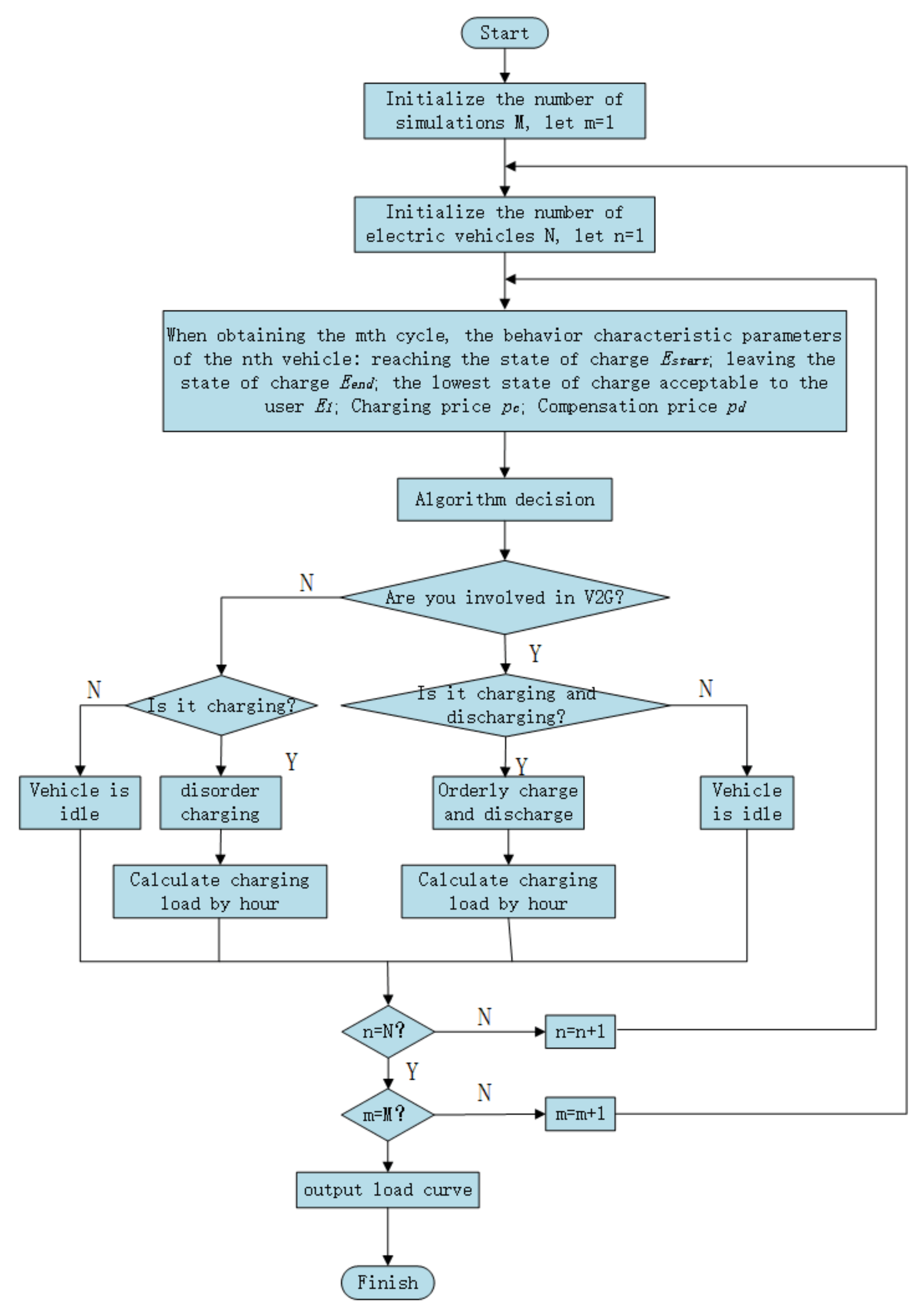
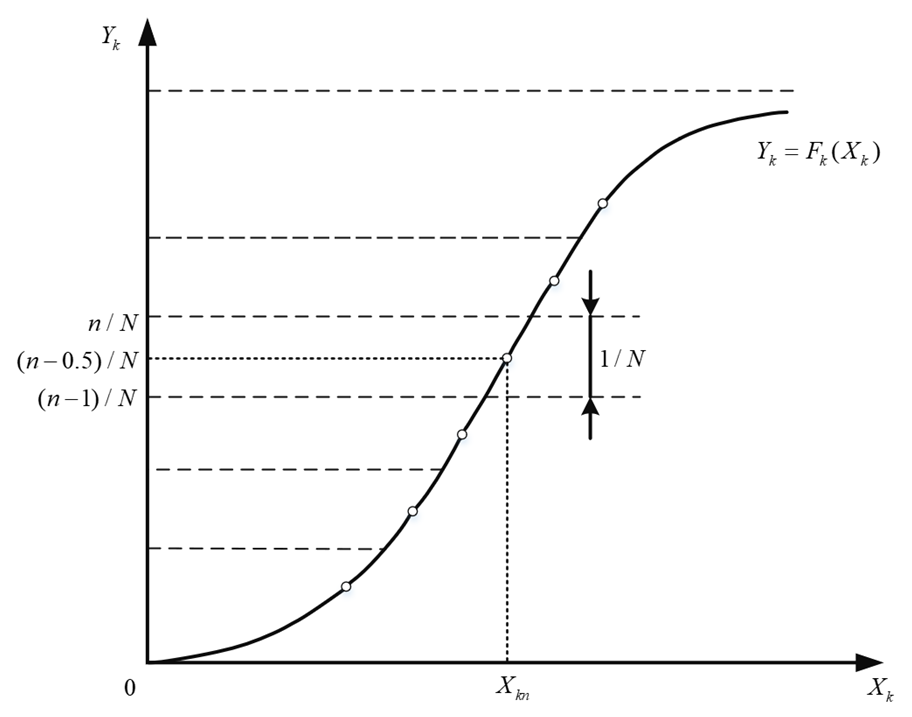
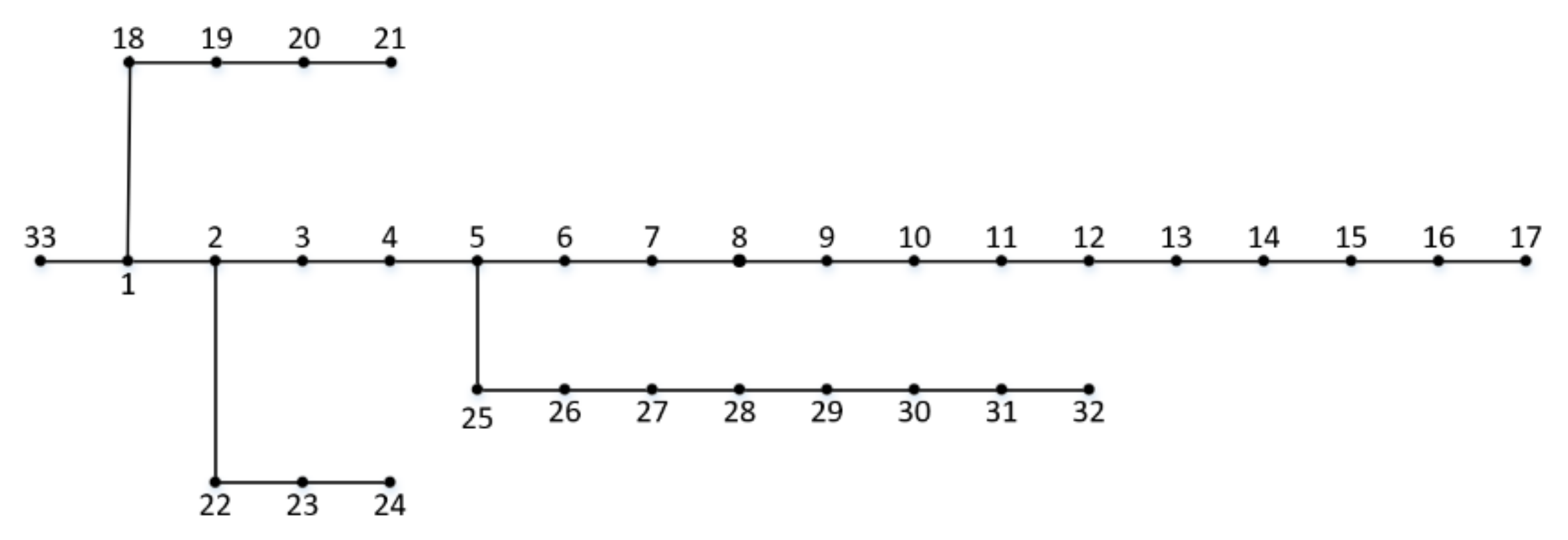
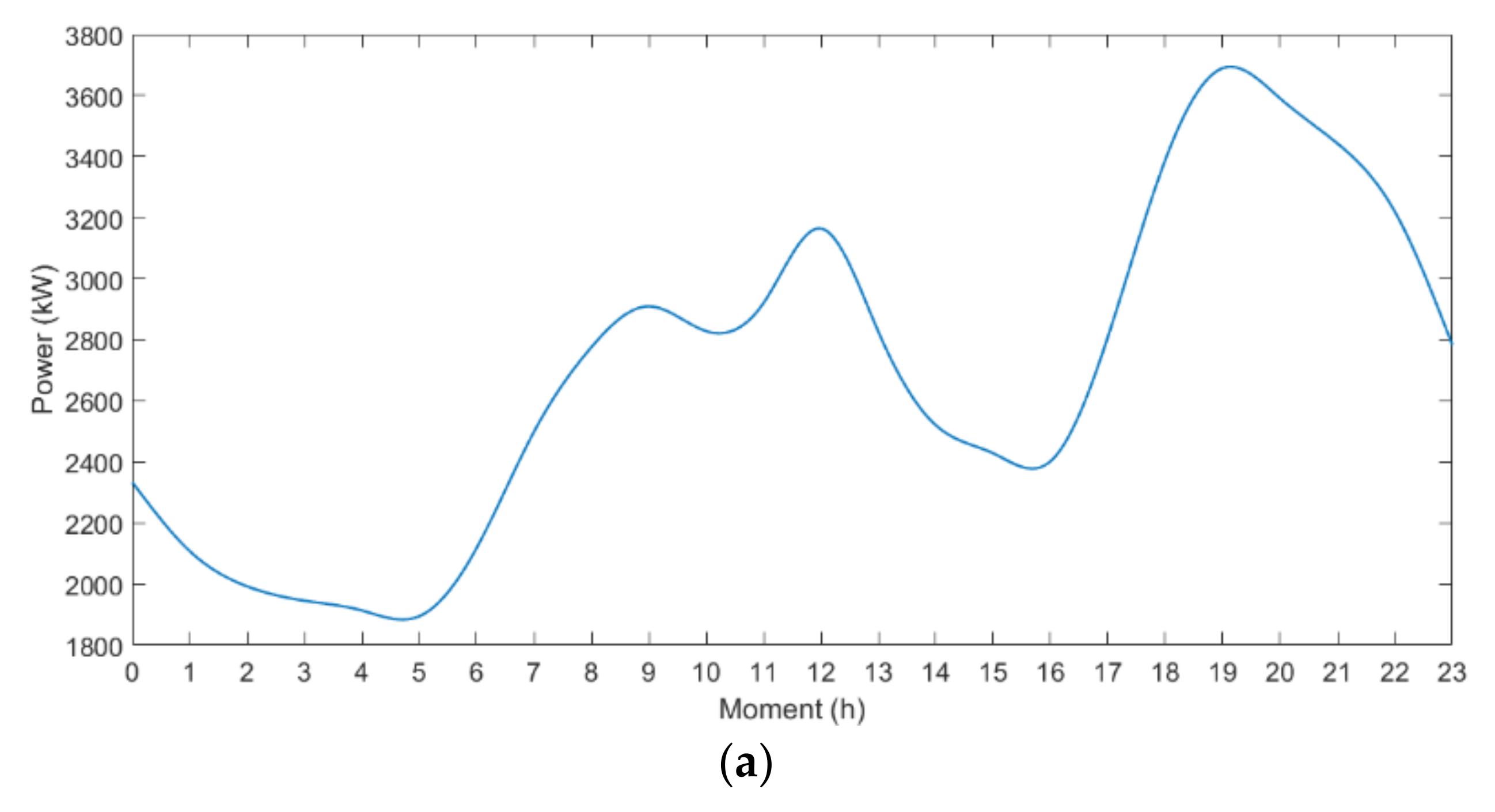
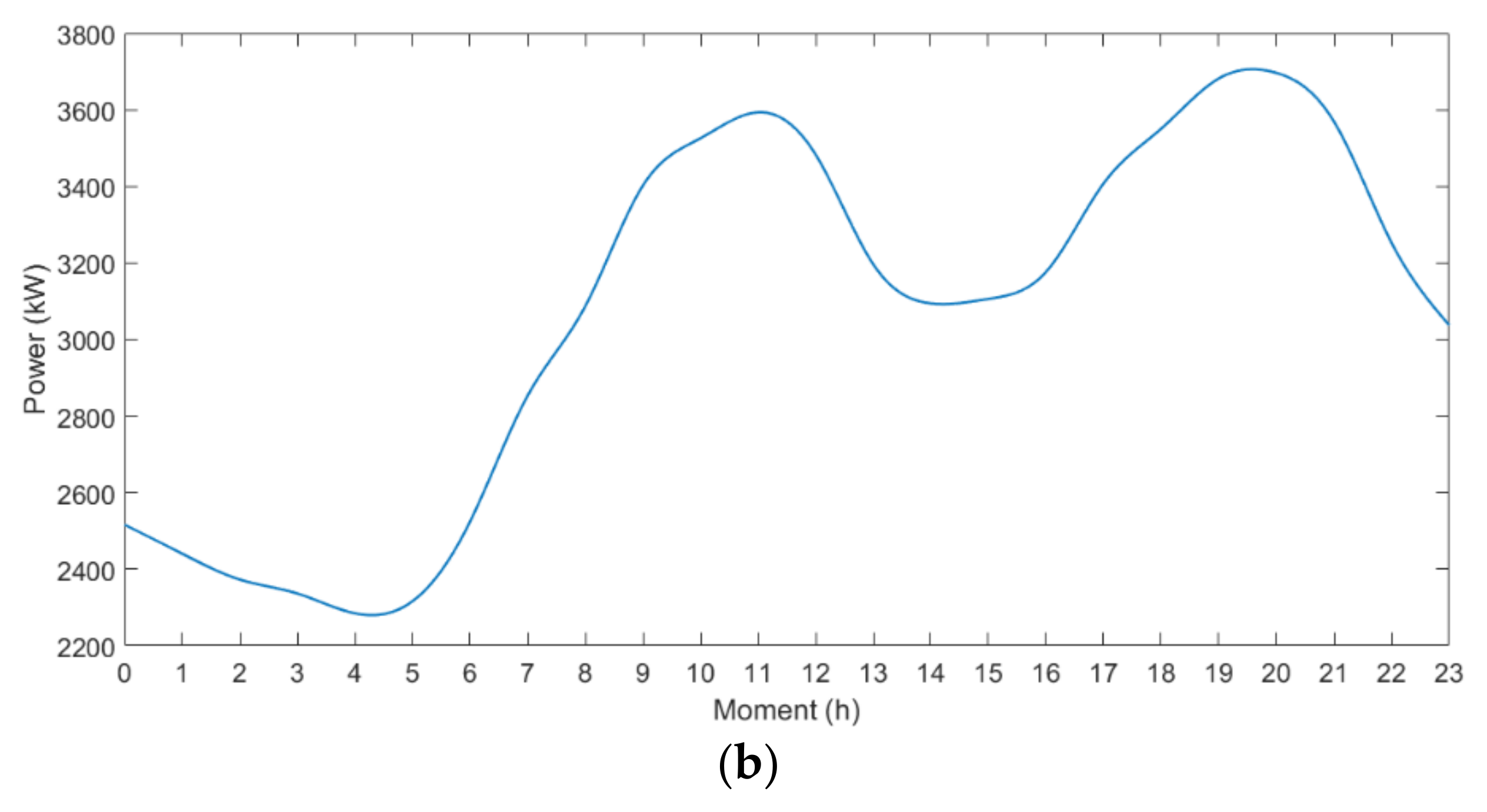

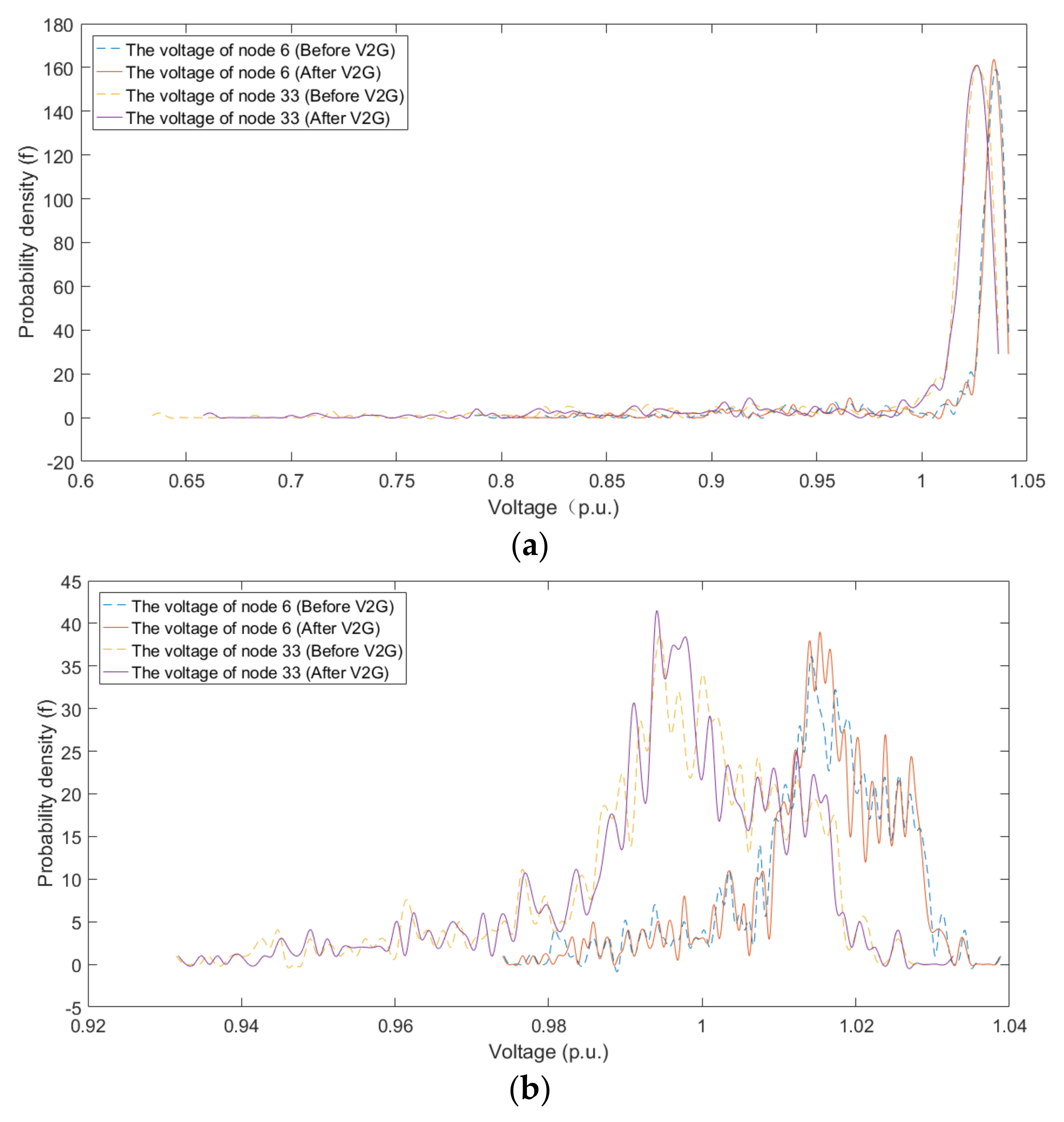
| Category | Description |
|---|---|
| Sc,d | The vehicle is involved in charge and discharge |
| Sd | Vehicles are only involved in discharge |
| Sc | The vehicle is only involved in charging |
| S0 | Vehicles are idle |
| Symbol | Description |
|---|---|
| pd | The compensatory electricity price expected by the owner, yuan/(kW·h) |
| pc | The charging price expected by the owner, yuan/(kW·h) |
| Δtp | The length of the vehicle’s downtime, h |
| Δts | Vehicle dispatch duration, h |
| Eend | The state of charge when the vehicle leaves |
| E1 | The lowest state of charge acceptable to the owner |
| Estart | The state of charge at the time of arrival of the vehicle |
| Node | Mean | Variance | Node | Mean | Variance | ||||
|---|---|---|---|---|---|---|---|---|---|
| Before V2G | After V2G | Before V2G | After V2G | Before V2G | After V2G | Before V2G | After V2G | ||
| 2 | 1.0423 | 1.0426 | 0.0042 | 0.0040 | 18 | 0.7858 | 0.7968 | 0.1454 | 0.1389 |
| 3 | 1.0049 | 1.0069 | 0.0246 | 0.0234 | 19 | 1.0411 | 1.0415 | 0.0048 | 0.0046 |
| 4 | 0.9844 | 0.9871 | 0.0358 | 0.0342 | 20 | 1.0330 | 1.0336 | 0.0092 | 0.0088 |
| 5 | 0.9639 | 0.9674 | 0.0471 | 0.0451 | 21 | 1.0313 | 1.0320 | 0.0101 | 0.0096 |
| 6 | 0.9141 | 0.9196 | 0.0745 | 0.0743 | 22 | 1.0298 | 1.0305 | 0.0109 | 0.0104 |
| 7 | 0.9026 | 0.9085 | 0.0808 | 0.0774 | 23 | 0.9962 | 0.9989 | 0.0293 | 0.0277 |
| 8 | 0.8868 | 0.8732 | 0.0895 | 0.0856 | 24 | 0.9797 | 0.9835 | 0.0382 | 0.0359 |
| 9 | 0.8455 | 0.8541 | 0.1013 | 0.0968 | 25 | 0.9716 | 0.9762 | 0.0426 | 0.0398 |
| 10 | 0.8455 | 0.8541 | 0.1122 | 0.1073 | 26 | 0.9094 | 0.9151 | 0.0770 | 0.0737 |
| 11 | 0.8426 | 0.8513 | 0.1139 | 0.1088 | 27 | 0.9032 | 0.9091 | 0.0805 | 0.0770 |
| 12 | 0.8373 | 0.8463 | 0.1168 | 0.1116 | 28 | 0.8781 | 0.8849 | 0.0942 | 0.0903 |
| 13 | 0.8154 | 0.8254 | 0.1290 | 0.1231 | 29 | 0.8603 | 0.8677 | 0.1040 | 0.0997 |
| 14 | 0.8071 | 0.8174 | 0.1336 | 0.1276 | 30 | 0.8521 | 0.8598 | 0.1085 | 0.1040 |
| 15 | 0.8014 | 0.8118 | 0.1367 | 0.1306 | 31 | 0.8388 | 0.8474 | 0.1158 | 0.1109 |
| 16 | 0.7961 | 0.8067 | 0.1397 | 0.1335 | 32 | 0.8358 | 0.8446 | 0.1175 | 0.1124 |
| 17 | 0.7882 | 0.7990 | 0.1441 | 0.1377 | 33 | 0.8351 | 0.8439 | 0.1179 | 0.1128 |
| Node | Mean | Variance | Node | Mean | Variance | ||||
|---|---|---|---|---|---|---|---|---|---|
| Before V2G | After V2G | Before V2G | After V2G | Before V2G | After V2G | Before V2G | After V2G | ||
| 2 | 1.0474 | 1.0474 | 0.0011 | 0.0011 | 18 | 0.9714 | 0.9708 | 0.0342 | 0.0345 |
| 3 | 1.0349 | 1.0349 | 0.0065 | 0.0065 | 19 | 1.0469 | 1.0469 | 0.0014 | 0.0013 |
| 4 | 1.0285 | 1.0284 | 0.0094 | 0.0093 | 20 | 1.0434 | 1.0436 | 0.0029 | 0.0027 |
| 5 | 1.0220 | 1.0220 | 0.0012 | 0.0012 | 21 | 1.0427 | 1.0429 | 0.0032 | 0.0030 |
| 6 | 1.0068 | 1.0066 | 0.0188 | 0.0188 | 22 | 1.0421 | 1.0423 | 0.0034 | 0.0033 |
| 7 | 1.0035 | 1.0032 | 0.0202 | 0.0203 | 23 | 1.0316 | 1.0317 | 0.0079 | 0.0079 |
| 8 | 0.9990 | 0.9986 | 0.0222 | 0.0223 | 24 | 1.0254 | 1.0256 | 0.0107 | 0.0105 |
| 9 | 0.9928 | 0.9925 | 0.0249 | 0.0250 | 25 | 1.0225 | 1.0226 | 0.0119 | 0.0118 |
| 10 | 0.9873 | 0.9868 | 0.0273 | 0.0275 | 26 | 1.0053 | 1.0051 | 0.0195 | 0.0195 |
| 11 | 0.9865 | 0.9860 | 0.0276 | 0.0278 | 27 | 1.0033 | 1.0032 | 0.0203 | 0.0203 |
| 12 | 0.9850 | 0.9845 | 0.0283 | 0.0285 | 28 | 0.9955 | 0.9954 | 0.0238 | 0.0237 |
| 13 | 0.9791 | 0.9785 | 0.0309 | 0.0311 | 29 | 0.9900 | 0.9900 | 0.0262 | 0.0261 |
| 14 | 0.9768 | 0.9763 | 0.0318 | 0.0321 | 30 | 0.9874 | 0.9874 | 0.0273 | 0.0273 |
| 15 | 0.9754 | 0.9748 | 0.0325 | 0.0328 | 31 | 0.9835 | 0.9834 | 0.0290 | 0.0290 |
| 16 | 0.9740 | 0.9734 | 0.0331 | 0.0334 | 32 | 0.9826 | 0.9826 | 0.0294 | 0.0294 |
| 17 | 0.9720 | 0.9714 | 0.0340 | 0.0342 | 33 | 0.9824 | 0.9823 | 0.0295 | 0.0295 |
Publisher’s Note: MDPI stays neutral with regard to jurisdictional claims in published maps and institutional affiliations. |
© 2022 by the authors. Licensee MDPI, Basel, Switzerland. This article is an open access article distributed under the terms and conditions of the Creative Commons Attribution (CC BY) license (https://creativecommons.org/licenses/by/4.0/).
Share and Cite
Chen, W.; Zheng, L.; Li, H.; Pei, X. An Assessment Method for the Impact of Electric Vehicle Participation in V2G on the Voltage Quality of the Distribution Network. Energies 2022, 15, 4170. https://doi.org/10.3390/en15114170
Chen W, Zheng L, Li H, Pei X. An Assessment Method for the Impact of Electric Vehicle Participation in V2G on the Voltage Quality of the Distribution Network. Energies. 2022; 15(11):4170. https://doi.org/10.3390/en15114170
Chicago/Turabian StyleChen, Wei, Lei Zheng, Hengjie Li, and Xiping Pei. 2022. "An Assessment Method for the Impact of Electric Vehicle Participation in V2G on the Voltage Quality of the Distribution Network" Energies 15, no. 11: 4170. https://doi.org/10.3390/en15114170
APA StyleChen, W., Zheng, L., Li, H., & Pei, X. (2022). An Assessment Method for the Impact of Electric Vehicle Participation in V2G on the Voltage Quality of the Distribution Network. Energies, 15(11), 4170. https://doi.org/10.3390/en15114170





